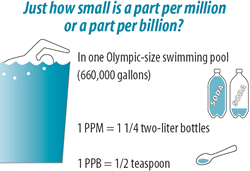Definiciones Y Términos
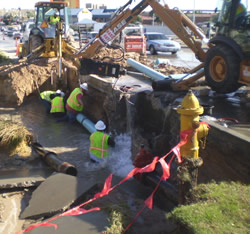
Water Authority technicians performing pressurized line repairs.
Action Level
The concentration of a contaminant which, if exceeded, triggers treatment or other requirements which a water system must follow. The Action Level is compared to the concentration detected in the 90th percentile sample.
Average
The total of the amounts found in all samples, divided by the number of samples taken.
CryptosporidiumA microbial pathogen found in surface water throughout the
U.S. If ingested, these parasites may produce symptoms of nausea, stomach cramps, diarrhea, and associated headaches.
Detected
The concentration of a substance measured at or above the USEPA specified Method Detection Limit.
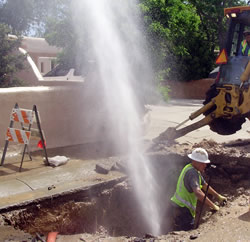
Water Authority technicians performing pressurized line repairs.
Distribution System
A network of pipes leading from a water tank
to customers’ plumbing systems. There are 3,100 miles of pipes in the distribution system.
Maximum Contaminant Level (MCL)
The highest level of a contaminant that is allowed in drinking water. MCLs are set as close to the MCLGs as feasible using the best available treatment technology.
Maximum Contaminant Level Goal (MCLG)
The level of a contaminant in drinking water below which there is no known or expected risk to health. MCLGs allow for a margin of safety.
Maximum Residual Disinfectant Level (MRDL)
The highest level of a disinfectant allowed in drinking water. There is convincing evidence that addition of a disinfectant is necessary for control of microbial contaminants.
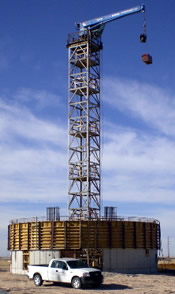
Reservoir construction.
Maximum Residual Disinfectant Level Goal (MRDLG)
The level of a drinking water disinfectant below which there is no known or expected risk to health. MRDLGs do not reflect the benefits of the use of disinfectants to control microbial contaminants.
MFL
Million fibers per liter
ND (< 1PPB)
Not-detected at the USEPA Method Detection Limit specified in parentheses.
picoCuries per liter (pCi/L)
A measure of radioactivity.
Entry Point to the Distribution System (EPTDS)
Ground water is moved from the wells to storage tanks in large diameter pipelines. The water is treated along the way. Treatment includes:
- Disinfection with sodium hypochlorite. Generated on-site from table salt and water, the product is like weak household bleach.
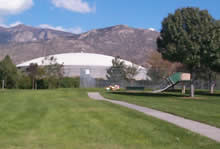
Lomas Tank
Purified surface water is pumped to certain storage tanks and blended with ground water.
From the valley to the heights, storage tanks are organized in trunks. Pump stations move water from one storage tank to another. The result is a mix of purified surface water and treated waters from many wells in each storage tank.
At the Entry Point to the Distribution System or the EPTDS, water from a storage tank enters the distribution system to deliver water to individual neighborhoods and customer taps by gravity flow. In some cases, treated water from an individual well enters the distribution system through a separate EPTDS.
The water system is made up of 20 distinct distribution zones as shown on the Zone Map. Specific EPTDS(s) provide water to each distribution zone. Water distributed within each distribution zone is of the same quality.
PPM
Parts per million, or milligrams per liter (mg/L). Compared to the volume in an Olympic-size swimming pool (660,000 gallons), the volume in 1 ¼ two-liter bottles (2 ½ liters) represents 1 part per million.
PPB
Parts per billion or micrograms per liter (µg/L). Compared to the volume in an Olympic-size swimming pool (660,000 gallons), the volume in ½ teaspoon represents 1 part per billion.
Range
The highest and lowest concentrations found.
Treatment Technique (TT)
A required process intended to reduce the level of a contaminant in drinking water.
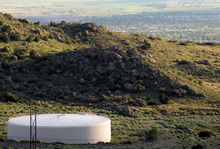
Sandia Reservoir
Turbidity
A measure of cloudiness of water.
Nephelometric Turbidity Unit (NTU)
A measure of the clarity of water.
Water Tank
Steel or concrete tanks used for water storage.

